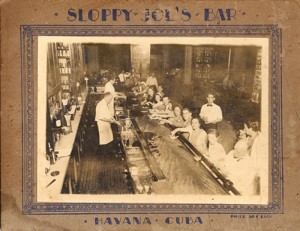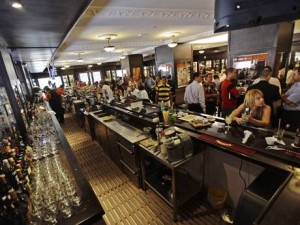A couple of years ago I could visit the ruins of Sloppy Joe’s. The metallic curtains of the Havana mythical bar, closed for decades, were run for the team that would film a documentary.
We were granted permission to enter a place that had become a cave. Once we were inside we could see the rats running around the place, the leaking from the ceiling had formed stalactites and there was almost nothing left of the mirrors. But the bar was still there, magnificent. Someone from the filming team poured water on the floor at the entrance and he was able to clear the dirt. Suddenly, the sign came out as the moon. Sloppy Joe was open for a moment. It was party time, the musicians played their instruments again.
http://youtu.be/3_cBT6m2pjI
2013
It’s happy hour again at Sloppy Joe’s saloon, a celebrated Cuban bar that has reopened after a hiatus of nearly half a century and which is sure to become a must-see for tourists eager to drink in the flavour of Havana’s freewheeling past.
Pictures lining columns in the bar bring the city’s colourful history vividly to life, reminders of Sloppy Joe’s popularity with US tourists in the Prohibition years of the 1920s and early 1930s when they made Havana, just 90 miles from Florida, their party-time playground. One photo shows Ernest Hemingway, Noël Coward and Alec Guinness together when Guinness was in town to film Our Man In Havana, which included a scene shot in the bar. The film was showing on twin flat-screen televisions above the bar on Friday.
The bar was closed in 1965 as Fidel Castro’s Communist government nationalised nearly all private enterprise, and left to decay until the City Historian’s Office, a government agency, started to restore the building in 2007. Historians, architects and designers pored over archive photographs and interviewed old-timers in the attempt to recreate Joe’s as faithfully as possible, down to the delicate plaster moulding, dark wood panelling and multi-hued bottles of alcohol displayed behind glass. The mahogany bar, once reputedly the longest in Latin America at about 59 feet (18 metres), was polished to a high shine.
In Our Man In Havana, Graham Greene wrote: “No Havana resident ever went to Sloppy Joe’s because it was the rendezvous of tourists.” That will no doubt be largely true during Joe’s second lease on life. The bar stands between several high-end tourist hotels and is mere steps from some of Havana’s most important museums. A Sloppy sandwich and a cocktail will set you back US$13 (£8.50) plus tip, far too pricey for Cubans who scrape by on government salaries averaging $20 a month.
But tourists in search of a piece of history are sure to flock here to have their picture taken at the joint patronised by everyone from Frank Sinatra and Ava Gardner to Nat King Cole. They will include increasing numbers of Americans, tens of thousands of whom are travelling to the island each year on cultural exchange tours that are tightly scripted but usually include some free time in the evenings.
Tangy Sloppy Joe sandwiches were purportedly first dreamed up here, although others also claim to have invented them. They arrive with the tomato-and-green-olive-spiced ground beef piled high and spilling out of the bun, looking more like a tiny hat. Best to skip breakfast before ordering one, and multiple napkins are recommended.
Waiters in black and orange shirts and matching ties shook up round after round of the Sloppy Joe cocktail on Friday, a refreshing blend of brandy, port and Cointreau, with a fruity pineapple finish, while about two dozen customers took a break from the spring heat and enjoyed tapas such as ceviche and marinated shrimps.
“Finally, the big day, after so much waiting, and I think it’s been worth the pain,” said Ernesto Iznaga, manager of the reborn Joe’s. “May all our clients… upon entering, breathe in that 1950s atmosphere that characterised the place.”
Barbara Bachman, a New York book designer, was one of the first to order a drink. Bachman, who was on her annual trip to the island to visit family with her Cuban-born husband, said she learned about the bar from photos she found at Havana flea markets. Curious, she asked around and finally managed to track it down several years ago. Peering through holes in the wall, she said, it was just a pile of dust and a few sticks of furniture.
Sources: SloppyJoe’s/various/youtube/InternetPhotos/www.thecubanhistory.com
Returning from the past Havana’s Sloppy Joe
The Cuban History, Arnoldo Varona, Editor
Regresa de la Habana del pasado el “Sloppy Joe” (Video
Hace un par de años pude visitar las ruinas del Sloppy Joe. Las cortinas metálicas del mítico bar La Habana, cerrado por décadas, se llevaron a cabo por el equipo que filmar un documental.
Nos concedieron el permiso para entrar en un lugar que se había convertido en una cueva. Una vez dentro podemos ver las ratas corriendo por el lugar, la filtración del techo habían formado estalactitas y no había casi nada de los espejos. Sin embargo, el bar todavía estaba allí, magnífico. Alguien del equipo de filmación se vierte agua en el suelo a la entrada y que fue capaz de despejar la tierra. De repente, la señal salió como la luna. Sloppy Joe estaba abierto por un momento. Ya era hora de partido, los músicos tocaban sus instrumentos de nuevo.
http://youtu.be/3_cBT6m2pjI
2013
Es la hora feliz de nuevo en el salón de Sloppy Joe, un bar cubano célebre que ha vuelto a abrir después de un paréntesis de casi medio siglo y que seguramente se convertirá en una visita obligada para los turistas deseosos de beber en el sabor del pasado irresponsable de La Habana.
Fotos columnas de revestimiento en la barra de traer la colorida historia de la ciudad llenos de vida, recuerdos de popularidad Sloppy Joe con los turistas de Estados Unidos en los años de la Prohibición de la década de 1920 y principios de 1930, cuando hicieron Habana, a solo 90 millas de Florida, su patio de recreo, el tiempo del partido. Una foto muestra a Ernest Hemingway, Noël Coward y Alec Guinness Guinness juntos cuando estaba en la ciudad para filmar Nuestro hombre en La Habana, que incluyó una escena filmada en el bar. La película se muestra en los televisores de pantalla plana individuales por encima del bar el viernes.
El bar estaba cerrado en 1965 cuando el gobierno comunista de Fidel Castro nacionalizó casi todas las empresas privadas, y se fue a decaer hasta que la Oficina del Historiador, una agencia del gobierno, comenzó a restaurar el edificio en 2007. Historiadores, arquitectos y diseñadores estudiaron minuciosamente fotografías de archivo y entrevistaron a los veteranos en el intento de recrear Joe de la manera más fiel posible, hasta la delicada moldura de escayola, paneles de madera oscura y las botellas multicolores de alcohol aparece detrás de un cristal. La barra de caoba, una vez conocido por ser el más largo de América Latina, a unos 59 pies (18 metros), fue pulido a un alto brillo.
En nuestro hombre en La Habana, Graham Greene escribió: “Ningún residente de La Habana nunca fue a Sloppy Joe porque era el punto de reunión de turistas.” Eso, sin duda, en gran parte cierto durante segundo contrato de Joe en la vida. El bar se encuentra entre varios hoteles turísticos de gama alta y está a pocos pasos de algunos de los museos más importantes de La Habana. Un sándwich descuidado y un cóctel le costará 13 dólares EE.UU. (8,50 €) más la propina, demasiado caro para los cubanos que sobreviven con salarios estatales promedio de $ 20 al mes.
Pero los turistas en busca de un pedazo de la historia seguro que acuden aquí para tomarse una foto en la articulación frecuentado por todos, desde Frank Sinatra y Ava Gardner a Nat King Cole. Se incluirá un número creciente de estadounidenses, decenas de miles de los cuales viajan a la isla cada año en viajes de intercambio cultural que son fuertemente con guión, pero por lo general incluyen algo de tiempo libre por las tardes.
Picante sándwiches Sloppy Joe fueron supuestamente soñado por primera vez aquí, aunque otros también afirman que ellos han inventado. Llegan con la carne picada de tomate y verde-oliva con especias apilados y se derrama del pan, más parecido a un pequeño sombrero. Lo mejor es saltarse el desayuno antes de pedir uno, y varias servilletas son recomendables.
Camareros con camisas negras y naranja y corbata a juego sacudieron ronda tras ronda del Sloppy Joe cóctel el viernes, una refrescante mezcla de brandy, el puerto y Cointreau, con un final frutal de piña, mientras que cerca de dos docenas de clientes tomaron un descanso del calor de primavera y disfrutó de tapas como ceviche y camarones marinados.
“Finalmente, el gran día, después de tanta espera, y creo que ha valido la pena”, dijo Ernesto Iznaga, gerente del renacer de Joe. “Que todos nuestros clientes … al entrar, respirar en ese ambiente de 1950 que caracterizó el lugar.”
Barbara Bachman, un diseñador de libros de Nueva York, fue uno de los primeros en pedir una bebida. Bachman, que estaba en su viaje anual a la isla para visitar a la familia con su esposo de origen cubano, dijo que se enteró de la barra de las fotos que encontró en mercados de pulgas Habana. Curioso, le preguntó a su alrededor y finalmente logró localizarlo hace varios años. Mirando a través de los agujeros en la pared, me dijo, era sólo un montón de polvo y unos pocos muebles.
Sources: SloppyJoe’s/various/youtube/InternetPhotos/www.thecubanhistory.com
Returning from the past Havana’s Sloppy Joe
The Cuban History, Arnoldo Varona, Editor







